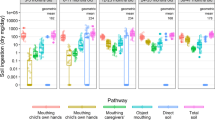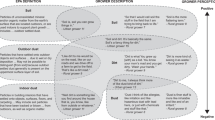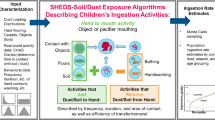Abstract
Soil and dust ingestion by children may be important pathways of exposure to environmental contaminants. Contaminated soil and dust may end up on children’s hands and objects, because they play close to the ground. These contaminants can be ingested by children, because they have a tendency to place objects, including their fingers, in their mouths. Assessing exposure through this pathway requires information about the amount of soil and dust ingested by children. Estimates of soil and dust ingestion and information on the prevalence of the behavior have been published in the literature, but research in this area is generally limited. Three methodologies have been used to quantify soil and dust ingestion rates. In this paper, these are referred to as the tracer element method, the biokinetic model comparison method, and the activity pattern method. This paper discusses the information available on the prevalence of soil and dust ingestion behavior, summarizes the three methodologies for quantifying soil and dust ingestion, and discusses their limitations. Soil ingestion data derived from studies that use these methodologies are also summarized. Although they are based on different estimation approaches, the central tendency estimates of soil and dust ingestion derived from the three methodologies are generally comparable.
This is a preview of subscription content, access via your institution
Access options
Subscribe to this journal
Receive 6 print issues and online access
$259.00 per year
only $43.17 per issue
Buy this article
- Purchase on Springer Link
- Instant access to full article PDF
Prices may be subject to local taxes which are calculated during checkout
Similar content being viewed by others
References
Lanphear BP, Matte TD, Rogers J, Clickner RP, Dietz B, Bornschein RL et al. The contribution of lead-contaminated house dust and residential soil to children's blood lead levels. A pooled analysis of 12 epidemiologic studies. Environ Res 1998; 79: 51–68.
Lanphear BP, Hornung R, Ho M, Howard CR, Eberly S, Knauf K . Environmental lead exposure during early childhood. J Pediatrics 2002; 140: 40–47.
Manton WI, Angle CR, Stanek KL, Reese YR, Kuehnemann TJ . Acquisition and retention of lead by young children. Environ Res 2000; 82: 60–80.
Gavrelis N, Sertkaya A, Bertelsen L, Cuthbertson B, Phillips L, Moya J . An analysis of the proportion of the U.S. population that ingests soil or other non-food substances. Hum Ecol Risk Assess 2011; 17: 996–1012.
U.S. EPA (Environmental Protection Agency) Exposure factors handbook: 2011 edition. Washington, DC: U.S. Environmental Protection Agency, National Center for Environmental Assessment, 2011 Report No.: EPA/600/R-09/052F.
Ozkaynak H, Xue J, Zartarian VG, Glen G, Smith L . Modeled estimates of soil and dust ingestion rates for children. Risk Anal 2011; 31: 592–608.
Calabrese EJ, Stanek ES . Distinguishing outdoor soil ingestion from indoor dust ingestion in a soil pica child. Regul Toxicol Pharmacol 1992; 15: 83–85.
Calabrese EJ, Stanek EJ . What proportion of household dust is derived from outdoor soil? J Soil Contam 1992; 1: 253–263.
Davis S, Waller P, Buschbom R, Ballou J, White P . Quantitative estimates of soil ingestion in normal children between the ages of 2 and 7 years: population-based estimates using aluminum, silicon, and titanium as soil tracer elements. Arch Environ Health 1990; 45: 112–122.
Wiley JA, Robineson JP, Cheng VT, Piazza T, Stark L, Pladsen K Study of children's activity patterns: final report. Sacramento, CA: California Air Resources Board, 1991 Report No.: ARB-R-93/489.
Dickens D, Ford RN . Geophagy (dirt eating) among Mississippi negro school children. Am Soc Rev 1942; 7: 59–65.
Cooper M . Pica: a Survey of the Historical Literature as Well as Reports From the Fields of Veterinary Medicine and Anthropology, the Present Study of Pica in Young Children, and a Discussion of its Pediatric and Psychological Implications. Charles C. Thomas Publishers: Springfield, IL, USA. 1957, 114 pp.
Baltrop D . The prevalence of pica. Am J Dis Child 1966; 112: 116–123.
Bruhn CM, Pangborn RM . Reported incidence of pica among migrant families. J Am Diet Assoc 1971; 58: 417–420.
Robischon P . Pica practice and other hand-mouth behavior and children's developmental level. Nurs Res 1971; 20: 4–16.
Vermeer DE, Frate DA . Geophagia in rural Mississippi: environmental and cultural contexts and nutritional implications. Am J Clin Nutr 1979; 32: 2129–2135.
Stanek EJ, Calabrese EJ, Mundt K, Pekow P, Yeatts KB . Prevalence on soil mouthing/ingestion among healthy children aged 1 to 6. J Soil Contam 1998; 7: 227–242.
Choi BC, Pak AW . A catalog of biases in questionnaires. Prev Chronic Dis 2005; 2: A13.
Fowler FJ, Mangione TW . Standardized Survey Interviewing: Minimizing Interviewer-Related Error. Sage Publications, Inc: Newbury Park, CA, USA. 1990.
Stanek EJ, Calabrese EJ, Xu B . Meta-analysis of mass-balance studies of soil ingestion in children. Risk Anal 2012; 32: 433–447.
Davis S, Mirick DK . Soil ingestion in children and adults in the same family. J Expo Sci Environ Epidemiol 2006; 16: 63–75.
Calabrese EJ, Stanek EJ, 3rd, Pekow P, Barnes RM . Soil ingestion estimates for children residing on a superfund site. Ecotoxicol Environ Saf 1997; 36: 258–268.
Barnes RM . Childhood soil ingestion: how much dirt do kids eat? Anal Chem 1990; 62: 1023A–1026AA 30A-33A.
Calabrese EJ, Barnes R, Stanek EJ, 3rd, Pastides H, Gilbert CE, Veneman P et al. How much soil do young children ingest: an epidemiologic study. Regul Toxicol Pharmacol 1989; 10: 123–137.
Calabrese EJ, Stanek EJ, 3rd . Resolving intertracer inconsistencies in soil ingestion estimation. Environ Health Perspect 1995; 103: 454–457.
Clausing P, Brunekreef B, van Wijnen JH . A method for estimating soil ingestion by children. Int Arch Occup Environ Health 1987; 59: 73–82.
Van Wijnen JH, Clausing P, Brunekreff B . Estimated soil ingestion by children. Environ Res 1990; 51: 147–162.
Stanek EJ, Calabrese EJ . Soil ingestion estimates for use in site evaluations based on the best tracer method. Hum Ecol Risk Assess 1995; 1: 133–156.
Stanek EJ, Xu B, Calabrese EJ . Equation reliability of soil ingestion estimates in mass-balance soil ingestion studies. Risk Anal 2012; 32: 448–462.
Binder S, Sokal D, Maughan D . Estimating soil ingestion: the use of tracer elements in estimating the amount of soil ingested by young children. Arch Environ Health 1986; 41: 341–345.
Wong MS The role of environmental and host behavioural factors in determining exposure to infection with Ascaris lumbricoldes and Trichuris trichiura [PhD thesis]. University of the West Indes 1988.
Calabrese EJ, Stanek EJ . Soil pica: not a rare event. J Environ Sci Health A. 1993; 28: 373–384.
Calabrese EJ, Stanek EJ, Barnes RM . Soil ingestion rates in children identified by parental observation as likely high soil ingesters. J Soil Contam 1997; 6: 271–279.
Thompson KM, Burmaster DE . Parametric distributions for soil ingestion by children. Risk Anal 1991; 11: 339–342.
Stanek EJ, Calabrese EJ, Zorn M . Soil ingestion distributions for Monte Carlo risk assessment in children. Hum Ecol Risk Assess 2001; 7: 357–368.
Adriano DC . Trace Elements in Terrestrial Environments: Biogeochemistry, Bioavailability, and Risks of Metals 2nd edn. Springer-Verlag: New York, NY, USA. 1986.
Valentin J . Basic Anatomical and Physiological Data for Use in Radiological Protection: Reference Values. Pergamon Press: New York, NY, USA. 2003 (ICRP Publication; 89).
Powell JJ, Ainley CC, Harvey RS, Mason IM, Kendall MD, Sankey EA et al. Characterisation of inorganic microparticles in pigment cells of human gut associated lymphoid tissue. Gut 1996; 38: 390–395.
Shepherd NA, Crocker PR, Smith AP, Levison DA . Exogenous pigment in Peyer's patches. Hum Pathol 1987; 18: 50–54.
Carlisle EM . Biochemical and morphological changes associated with long bone abnormalities in silicon deficiency. J Nutr 1980; 110: 1046–1056.
U.S. EPA (Environmental Protection Agency). General principles for performing aggregate exposure and risk assessments. U.S. EPA, Office of Pesticide Programs: Washington, DC, USA. 2001.
Hogan K, Marcus A, Smith R, White P . Integrated exposure uptake biokinetic model for lead in children: empirical comparisons with epidemiologic data. Environ Health Perspect 1998; 106 (Suppl 6): 1557–1567.
von Lindern I, Spalinger S, Petroysan V, von Braun M . Assessing remedial effectiveness through the blood lead:soil/dust lead relationship at the Bunker Hill Superfund Site in the Silver Valley of Idaho. Sci Total Environ 2003; 303: 139–170.
Lepow ML, Bruckman L, Gillette M, Markowitz S, Robino R, Kapish J . Investigations into sources of lead in the environment of urban children. Environ Res 1975; 10: 415–426.
Lepow ML, Bruckman L, Rubino RA, Markowtiz S, Gillette M, Kapish J . Role of airborne lead in increased body burden of lead in Hartford children. Environ Health Perspect 1974; 7: 99–102.
Day JP, Hart M, Robinson MS . Lead in urban street dust. Nature 1975; 253: 343–345.
Duggan MJ, Williams S . Lead-in-dust in city streets. Sci Total Environ 1977; 7: 91–97.
Ferguson AC, Canales RA, Beamer P, Auyeung W, Key M, Munninghoff A et al. Video methods in the quantification of children's exposures. J Expo Sci Environ Epidemiol 2006; 16: 287–298.
Davis S, Myers PA, Kohler E, Wiggins C . Soil Ingestion in Children With Pica, Final Report. Fred Hutchinson Cancer Research Center: Seattle, WA, USA. 1995 Contract No.: U.S. EPA Cooperative Agreement CR 816334-01.
Groot ME, Lekkerkerk MC, Steenbekkers LPA . Mouthing Behavior of Young Children: an Observational Study. Agricultural University: Wageningen, The Netherlands. 1998, 104 pp.
Bierkens J, Van Holderbeke M, Cornelis C, Torfs R . Exposure through soil and dust ingestion. In: Swartjes FA, (ed.).. Dealing With Contaminated Sites: from Theories Towards Practical Applications. Springer. 2011, 1114 pp.
Xue J, Zartarian V, Moya J, Freeman N, Beamer P, Black K et al. A meta-analysis of children's hand-to-mouth frequency data for estimating nondietary ingestion exposure. Risk Anal 2007; 27: 411–420.
Xue J, Zartarian V, Tulve N, Moya J, Freeman N, Auyeung W et al. A meta-analysis of children's object-to-mouth frequency data for estimating non-dietary ingestion exposure. J Expo Sci Environ Epidemiol 2010; 20: 536–545.
Driver JH, Konz JJ, Whitmyre GK . Soil adherence to human skin. Bull Environ Contam Toxicol 1989; 43: 814–820.
Calabrese EJ, Stanek EJ, Barnes R, Burmaster DE, Callahan BG, Heath JS et al. Methodology to estimate the amount and particle size of soil ingested by children: implications for exposure assessment at waste sites. Regul Toxicol Pharmacol 1996; 24: 264–268.
ATSDR (Agency for Toxic Substances and Disease Registry) Summary report for the ATSDR soil-pica workshop. Atlanta, GA: U.S. Department of Health and Human Services, U.S. Department of Health and Human Services ATSDR 2001.
Geissler PW, Shulman CE, Prince RJ, Mutemi W, Mnazi C, Friis H et al. Geophagy, iron status and anaemia among pregnant women on the coast of Kenya. Trans Roy Soc Trop Med Hyg 1998; 92: 549–553.
Corbett RW, Ryan C, Weinrich SP . Pica in pregnancy: does it affect pregnancy outcomes? MCN Am J Matern Child Nurs 2003; 28: 183–189 quiz 90-1.
Rainville AJ . Pica practices of pregnant women are associated with lower maternal hemoglobin level at delivery. J Am Diet Assoc 1998; 98: 293–296.
Smulian JC, Motiwala S, Sigman RK . Pica in a rural obstetric population. South Med J. 1995; 88: 1236–1240.
Calabrese EJ, Stanek EJ, Gilbert CE . Evidence of soil-pica behaviour and quantification of soil ingested. Hum Exp Toxicol 1991; 10: 245–249.
Stanek EJ, 3rd, Calabrese EJ . Daily estimates of soil ingestion in children. Environ Health Perspect 1995; 103: 276–285.
Stanek EJ, 3rd, Calabrese EJ . Daily soil ingestion estimates for children at a Superfund site. Risk Anal 2000; 20: 627–635.
Acknowledgements
The editorial assistance provided by Vicki Soto is gratefully acknowledged. We also appreciate the contributions of Becky Cuthbertson, Laurie Schuda, Nicolle Tulve, and Karen Bradham. The views expressed in this paper are those of the authors and do not necessarily reflect the views or policies of the US Environmental Protection Agency.
Author information
Authors and Affiliations
Corresponding author
Ethics declarations
Competing interests
The authors declare no conflict of interest.
Rights and permissions
About this article
Cite this article
Moya, J., Phillips, L. A review of soil and dust ingestion studies for children. J Expo Sci Environ Epidemiol 24, 545–554 (2014). https://doi.org/10.1038/jes.2014.17
Received:
Accepted:
Published:
Issue Date:
DOI: https://doi.org/10.1038/jes.2014.17
This article is cited by
-
Assessing Contamination Levels and Risk of Toxic Elements in Soils from Automobile Workshop Centre in Asante Mampong, Ghana
Chemistry Africa (2024)
-
Exposure Factors vs. Bioaccessibility in the Soil-and-Dust Ingestion Pathway: A Comparative Assessment of Uncertainties Using MC2D Simulations in an Arsenic Exposure Scenario
Exposure and Health (2024)
-
Optimization of a method for collecting infant and toddler urine for non-target analysis using cotton pads and commercially available disposable diapers
Journal of Exposure Science & Environmental Epidemiology (2023)
-
A systematic characterization of soil/dust ingestion for typical subpopulations in China
Environmental Geochemistry and Health (2023)
-
Integrative assessment of urban dust polycyclic aromatic hydrocarbons using ground and satellite data in Iran
Environmental Monitoring and Assessment (2023)



